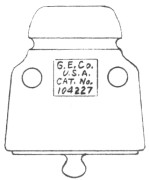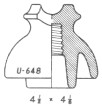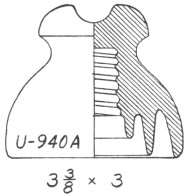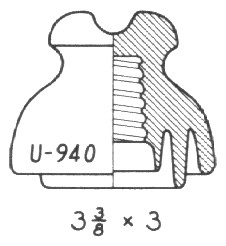Porcelain Insulator News
by Jack H. Tod
Reprinted from "INSULATORS - Crown Jewels of the Wire", July 1976, page 20
Dear Jack:
I was at a rummage sale and picked up a few porcelain pieces and wondered if
you would have any comment on them.
The first is a small Locke, but it is marked LCCKE, This is not a marking
error, but rather a badly pressed 0. There is a faint indentation closing up the
right side of the 0, but the glaze did not go into it. Only at close scrutiny
does it become apparent that it is an 0. Is this interesting at all to a
porcelain collector?

I am a glass-only collector, but I have around a dozen porcelains picked up
over the years which I want to put on my sale-trade list to make more room for
my collection. But, since I have never actively collected porcelains, I have no
book on them, or know the U- numbers, or have any idea as to the value of my
specimens. I'm sure that your big book on them is very interesting and would
include anything that I have, but I really can't afford a comprehensive book
that I would not get very much use out of. Can you recommend a book that costs
about $5 or so?
Finally, I would like to say that although I don't collect porcelains, I find
your column in CJ to be really interesting and I read it every month.
Paul Thornquist,
Milwaukee
- - - - - - - - -
Dear Paul:
No, collectors just ignore marking imperfections that result from the manner
in which handstamps are applied. The only thing of interest in these handstamps
is when the stamp itself had an error such as misspelled words or inverted
letters, and then usually only specialists would try to make room for the
variations. There are simply too many other interesting things to collect, and
shelf space is always at a premium for the general collectors.
By far, the book most suitable for your needs is "Porcelain Insulators
Photographed & Priced", by Frances M. Terrill, 116 pp, softbound, $3.
Order from Frank Peters (see CJ classified ad section). The pictures in it are
excellent and will identify or relate to most of your items. Its pricing is
pretty good, but common items tend to be a bit overpriced and rare items
underpriced.
Jack

Dear Jack:
I recently added a brown porcelain insulator shaped just like a mushroom with
a hole all the way through (see sketch at right). Could this be a rack spool or
"dead end" of some type?
Bruce Larson,
Longmont, Colo.
- - - - - - - - -
These are "shackle insulators" designed for deadending or breaking
bare signal wires. They are ordinarily mounted on shackles surrounding the
crossarm, but can also be used in clevises, forks, or rack arrangements. Shackle
insulators are much more common in glass (Hemingray), but many of the
porcelain companies also made them.
Jack
Dear Jack:
... The Bennington Museum in Bennington, Vermont has on display several styles of
porcelain insulators formerly made by the Bennington Company. These are all
threaded, pin-type and of ordinary styles. They do not have on display a U-982
(threadless, page 18, April 1976 Crown Jewels). The last time I talked with the
curator at the Bennington Museum, he denied the company had ever made such an
insulator, although the documentation certainly indicates it did.
The real point is, however, Bennington did make unmarked, threaded, pin-type
porcelain insulators in several common styles.
John H. Hall,
Canal Winchester, Ohio
- - - - - - - - -
Many thanks, John, for this information, all of which is new to me. Now if
some collector in the Bennington area can revisit the museum and record which
ordinary pin type styles (U- numbers) they made, we'll publish that information
too. I'm sure all collectors are dying to know which ones.
Jack

Dear Jack:
I have a U-459 Lapp with the incuse marking of The Lapp Insulator logo. From
your Supplement C to "Porcelain Insulators Guidebook ..." I determine
that this insulator was made in the second year quarter, but of what year I
can't tell. The year code notch around the oval is between where the 1922 and
1923 notches would be. Please let me know if you can figure out the year it was
made.
Bob Brandt,
Marion, Iowa
- - - - - - - - -
The Lapp date code drawing (also shown on page 17 of the August 1973 Crown
Jewels issue) is a direct copy (reduced in size) of the factory file drawing. I
can add nothing more. How 'bout 1922-1/2 for yours?!
Jack
Dear Jack:
One bit of information which I've been seeking for about 3 years has finally
been cornered. A number of antenna insulators I have are Navy part numbers.
These were probably from WW2, carry a three-letter prefix which is a code for
the manufacturer. Audio Development Co. was CUD, and a transformer we made, part
number 301528 as an example, then became CUD301528. Anyway, here are the ones I
have:
| CAL = Locke Insulator Co. |
CDP = General Ceramics Co. |
|
CAS =- American Lava Co. |
CNP = National Porcelain Co. |
|
CBJ = Ohio Brass Co. |
COP = Standard Plastics Co. |
|
CBO = Lapp Insulator Co. |
CNP = Porcelain Products Co. |
|
CBU = Isolantite, Inc. |
CSJ = Stupakoff Ceramics &
Mfg. Co. |
I do not know if these are of interest to anyone else. Perhaps some other
insulators than antenna types would have Navy numbers -- I just don't know.
Getting this information from the Govt. was a long game, a gross run around.
When I finally found the correct office to contact, got a complete phony list,
and as I knew at least one, Ohio Brass, had to go back with the info that I know
at least one is not as they listed. These sent the second time at least make
sense and I hope are correct. It is rather disgusting that some jerk, whom I
help pay, is too lazy to look up the info for such an inquiry.
Walter Lehnert,
Minneapolis
- - - - - - - - -
Yes, by all means we want to publish key information such as this in the
pages of Crown Jewels. It is not just a matter of helping one or two collectors
identify a specimen at this very time, but rather a case of making it part of
the permanent record. This is true also of considerable other research material
we've printed in the magazine all along.
Once we publish something in Crown Jewels, there is always an opportunity for
a later researcher to find it, even if he may spend a lot of time going through
back volumes. I have literally thousands of letters which contain all sorts of
info, and it would take 10 people a year to just scan through them. Anything
that doesn't get published in these CJ pages or in the various insulator books
will probably end up getting lost in the shuffle.
Jack
CORRECTION -- The insulators, including the rare Thomas transposition, on
page 21 of the April 1976 issue are those of Otto R. Boll, Appleton, Wisconsin.
I incorrectly credited that report to Walt Lehnert. My apologies to both Otto
and Walt for this goof. When I make up the column copy monthly, my desk is a
heap of books, catalogs, letters, etc. All this confusion occasionally wins out
over order!
Jack

Dear Jack:
Would appreciate any information you could give me on a white porcelain
insulator with T & N O RLY green underglaze marking on the skirt under the
wire groove. Also heard they are likewise marked on the dome. Would also like an
idea of what these insulators are worth.
T. J. Hamilton,
Englehart, Ont., Canada
- - - - - - - - - -
Seems as though I've heard of it before, but I can't locate the information
in my files or library of insulator books and magazines. Will some reader please
send us the info on this railway marking so we can print the answer.
I can't make a guess as to value of items of which I'm ignorant, but it's
obviously worth more than the more common railroad items such as C.F.R., C.N.R.,
etc.
Jack

We printed this answer in 1971, 1973 and lastly February 1974 column, but,
questions on it persist. For the benefit of new subscribers, then --
These are "primary fuse cutouts", made from the 1890's until recent
years. They are meant to be bolted to crossarms on secondary service poles and
are used to fuse the primary circuit at the transformer.
The removable plug has a replaceable fuse wire. There are numerous
variations due to vintage and different manufacturers, but all are generally
alike. A major second variety are long cylindrical ones as made by Lapp. These
are bracket mounted just as lightning arrestors are.
Although plugs on some models could be removed with a special "hot
stick" plug remover, this wasn't the case on some styles. Pulling these
plugs by hand so near the 13 Kv lines earned them the nickname "suicide
boxes". The more modern primary fusing method is with replaceable fuse
links mounted in spring clips across the lightning arrestor housings, and you
can see these on the alley transformer poles. Special telescopic poles allow
service men to replace these fuse links from the ground safely and quickly.
These would make a good specialty collection, since all carry markings --
sometimes those of porcelain companies but more usually names of the larger
electrical companies or manufacturers of the transformers. The modern varieties
are rather boring, but some early ones are spectacularly unusual for design,
glazes or markings. Collector trade value is law on modern versions from big
companies like Westinghouse or G.E., but very old and unusual ones are
"goodies".

Dear Jack:
Just back from a show where I acquired a nice porcelain piece. The size and
profile shape are "right on" for U- 648, but the threads go all the
way down to 7/8" from the bottom instead of as shown in the U-648 drawing.
It is unembossed, white, very crude and old looking. Numerous air bubbles in
the (unfired) clay show all over the insulator. The mold seam is very apparent
clear up over the top, including the top firing rest. The glaze is of poor
quality too, and the pin hole is unglazed.
As crude as this is, they sure didn't have any quality control when it was
made; as we used to say of things years ago, "Looks like the shoe-maker
made it". I like these crude old looking specimens and will be thankful for
any light you can shad on the origin etc.
Pat Gavan,
Mt. Dora, Florida
- - - - - - - - - -
On all counts, this is an early Pittsburg item -- the unglazed pin hole,
two-part forming mold, crudeness.
There isn't any other company who would be even a close second to Pittsburg
High Voltage for making the shoddiest quality one-piece pin type insulators,
much less shipping them to customers where they ended up in use on lines. This
was at least the situation in the first several years after the company was
founded in 1908 (in a plant previously owned by two china companies, and by a
displaced "pot" maker from East Liverpool, Ohio).
They actually shipped out virtually any whole insulator out of the kiln if
they would screw on a peg -- and quite a few that wouldn't. And then all those
with big blow-holes in the clay, big unglazed blotches, etc. I have personally
seen many Pittsburg insulators from utility company salvage with flashovers
through the gross mechanical imperfections in them.
Pittsburg probably achieved a terrible reputation almost instantly from this
inability (or unwillingness) to weed out defective insulators from shipments. It
is surprising that a big company such as Westinghouse became the selling agent
for Pittsburg insulators when all this was going on, and had bought a
controlling interest in the operation by 1914.
This lack of quality control at Pittsburg HV carried over into the
Westinghouse control, but there was evidently a gradual improvement in the
situation, as witnessed by the specimens made towards 1920. There was probably a
complete revamping of methods and controls by the time Westinghouse wholly owned
the company in 1922 and started marking and selling the insulators as
'Westinghouse" items. Even the earliest specimens known to have been made
after about 1920 are of comparatively high quality.
Jack

Emma Almeida (Shrewsbury, Mass) has earned another gold star this month! She
sent me a pair of #334 wiring cleats from several she found which have the
monogram S-H Co. marking shown at the left above. This very ornate marking is
also impressed in the cover of her large, hardbound 1912 (No. 7) catalog of
Stuart-Howland Co., Boston, Mass.
This catalog shows that Stuart-Howland was a typical electrical jobber of
that era. Emma sent prints of selected pages which indicate they sold the pin
type lines of Pittsburg and Thomas, plus standard porcelain and special
insulators as made by various manufacturers of the period.
The more plain and crude S H Co. monogram at the right above is from cleats I
located in dumpage of the Electrical Porcelain Co. plant in East Liverpool,
Ohio. I'm sure now that I incorrectly attributed this to Snyder-Hunt Co. in the
February 1974 CJ listing (page 24), and that it should have been Stuard-Howland
Co. Here again, the folly of trying to make attributions by the game of
"initial matching". SnyderHunt Co. normally just used the marking
"S-H Co.".

Reference Arthur Jones' newly discovered Imperial pin type (see June 1976 CJ
column), we've now completed making the drawing of it by remote control (shadow
profile and measured dimensions).
This insulator was fired upright on the outer rim, the middle petticoat being
slightly recessed as shown.
Whereas minor variations are not of particular interest on modern items, they
are on the early classics. This will be U-940A in the Universal Style Chart.
NOTICE -- I have approximately 850 mint porcelain pin types that have long
since served their purpose in my research and which must now be evicted so we
can get the car back into our garage! Nothing spectacular, all browns, mostly
various cable types of the 1920's to 1940's. Most are very pretty glazes.
The entire hoard FREE to the first one to physically come and pick them up.
Write or call (602-959-2445) first so I'll be home. If no one takes me up on
this before September, hello city dump. As added incentive, IOU toss in crates
of old guy strains of all types, wire holders, rack spools, old multipart pin
types, and several thousand nail knobs, cleats mid various "whatisits".
Wife says, "Please hurry".
Jack
Observations of readers: (1) That the P.O.D. which formerly stood for Post
Office Department now stands for Pony Overland Dispatch, and (2) that the 30%
increase in the first class postage rate last January was to pay for storage in
transit.
Dear Jack:
I am enclosing a foil impression of the very clear incuse KNOX marking on my
exchange. Note the marking is about the same overall size as the common recess-embossed KNOX marking, but the hobo-type letters are noticeably shorter in
height than on the incuse one. I also have the incuse marking on a yellow U-627B
which I got last fall, but I just recently spotted the different marking on it.

Here's another item I don't recall having been reported before. I have two
U-359, one white and one light blue, which do not have prepared firing rests.
All skirts are fully glazed. These are definitely Pittsburg insulators -- MOD,
flat pin hole, etc. Have you had any other reports of some type of stool firing
from PHVI Co.?
Lew Hohn,
Rochester, NY
- - - - - - - - - -
Dear Lew:
Many thanks for the report of this new KNOX marking, and it will be #(3) for
Knox pin types. I have checked all my Knox items and don't have one. As you
indicate, it would be easy to overlook it before its existence was pointed out.
Maybe other collectors will check their Knox shelves and give us some idea of
how scarce this marking stamp is compared to the normal recess-embossed marking
type.

No, no other reports from readers about stool fired PHV items, but guess
what? After putting your letter down, I checked mine and found I have two brown
U-359 without firing rests. These came from PHV plant dumpage and are the usual
MOD and unglazed flat top pin holes.
Since Pittsburg did so many other things in unorthodox fashion, including
manufacture of wet process pin types in two-piece forming molds, guess we
shouldn't be surprised at this new discovery. They could have stool-fired these
U-359 since they were popularly used in arc street light hanger systems, and
completely glazed exteriors would be an improvement in appearance on these.
Jack
Dear Jack:
... I just finished reading your article on the U-982 Bennington threadless in
Crown Jewels (April, P-17) and wish to make a correction. We bought it from
Forrest Jones almost two years ago and have it here with us now that we have
moved to Phoenix. If Jerry Turner has one, then there are two extant.
Dieline Coleman,
Phoenix
- - - - - - - - - -
Dear "Dee" and Gary:
No, I goofed in my memory of who bought this unique insulator from Forrest.
It's not unreasonable to imagine Jerry having something like that since his
fabulous collection seems to have just about all the goodies there are to get! I
know on whose shelves sit hundreds of the better porcelain items, but much of
that is only from my memory, and it's not always infallible.
Jack

Dear Jack:
I have a white porcelain insulator, triple petticoat, Sim U-940. The outer
two petticoats are flush, the inner one is recessed.
It has an Imperial Porcelain Works marking such as #2 on page 167 of your
book, with porcelain spelled correctly. It also has a marking such as #3
adjacent to the first one. Does this second imprint make it relatively scarce,
or is it somewhat common? Also, do you have a suggestion as to how to code it?
Arthur E. Jones,
Newcastle, Maine
- - - - - - - - -
Dear Arthur:
The second marking would only be adding extra frosting on a cake that is
already a very good one, since any newly reported Imperial style is already
worth yelling about.
Even the U-940 is a rare Imperial style, and I know of only two or three of
them in collections. They also have an Imperial marking (... for F. M. Locke /
Victor, N.Y. of Imperial Porcelain... etc.) on the skirt.
As for coding it, we will make a drawing of it for inclusion in the Universal
Style Chart if it's different from other early Imperials, and then you can just
record the U- number for it. (Transmission of drawing data still in progress.
See later CJ issue upcoming.) We continue to disregard minor variations on
modern styles in adding any new items to the Style Chart, but we are interested
in adding variations of the early classics and of the special insulators such as
transpositions., helmets, mines, patent tops, etc.
Jack
| 